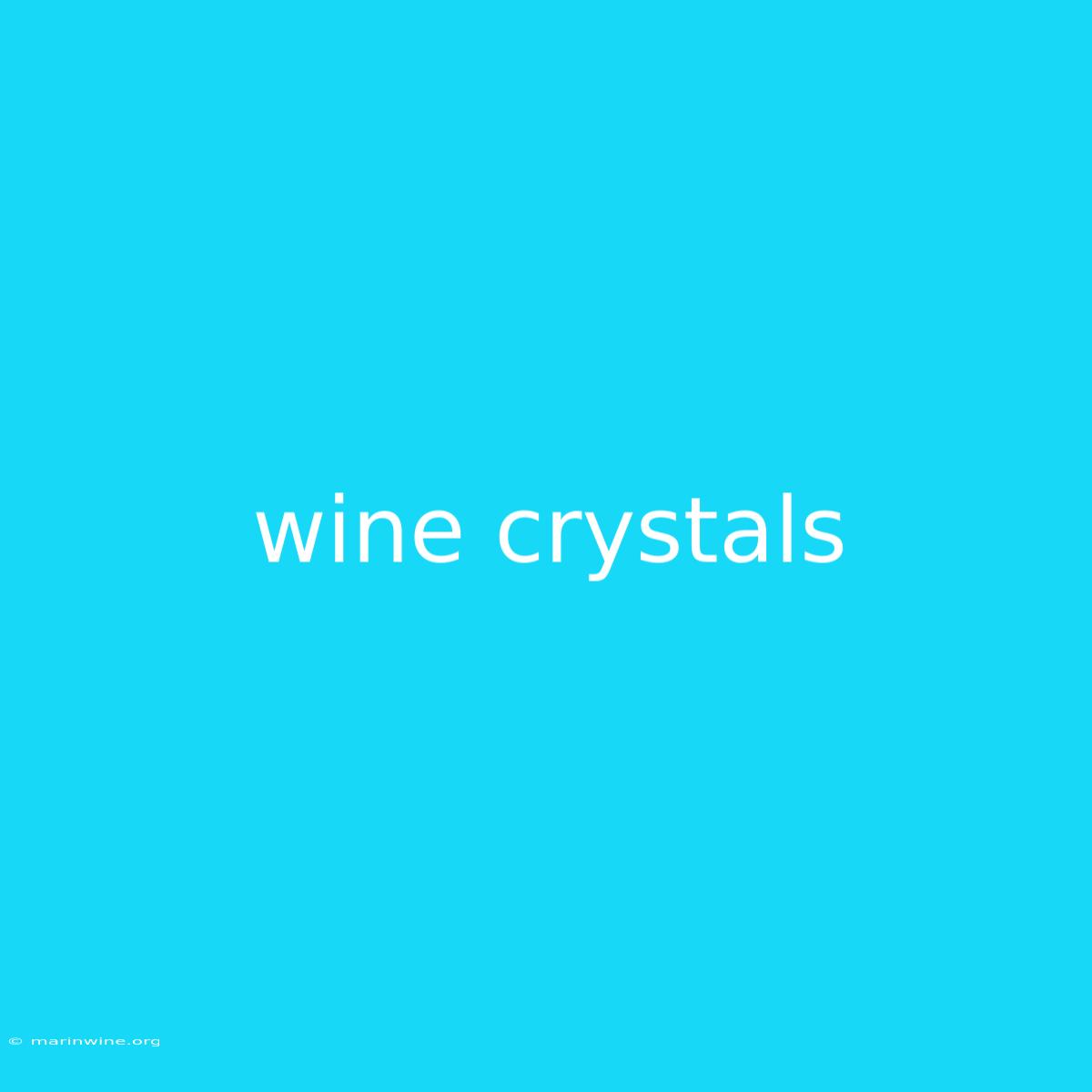Unveiling the Mystery: Wine Crystals – What Are They and Why Do They Form?
Have you ever noticed tiny, shimmering crystals in your favorite bottle of wine? It's not a sign of spoilage, but rather a fascinating natural phenomenon. These crystals, often referred to as wine diamonds, are a testament to the complex chemistry of winemaking.
Why It Matters: Understanding wine crystals is crucial for wine lovers, collectors, and even winemakers. Their presence can be a source of curiosity, confusion, and even concern. This article will demystify these sparkling particles, revealing their origins, implications, and why they are not a reason to worry.
Key Takeaways of Wine Crystals:
| Aspect | Description |
|---|---|
| Formation | Crystals form from naturally occurring tartaric acid in wine. |
| Appearance | Tiny, shimmering, often colorless crystals. |
| Taste | Crystals don't significantly affect wine's taste or aroma. |
| Occurrence | More common in white and red wines aged in bottles. |
| Safety | Harmless and not a sign of spoilage. |
Wine Crystals: A Closer Look
Introduction: Wine crystals, also known as tartaric acid crystals, are a natural byproduct of the winemaking process. While their presence might seem alarming, they are completely harmless and do not affect the wine's taste or quality.
Key Aspects:
- Tartaric Acid: The culprit behind these crystals is tartaric acid, a natural compound present in grapes. During fermentation and aging, tartaric acid can precipitate out of solution, forming crystals.
- Cold Temperatures: Crystal formation is more likely to occur at cooler temperatures. As wine chills, tartaric acid becomes less soluble, leading to crystallization.
- Wine Types: White wines, especially those made from cool-climate grapes, are more prone to crystal formation. Red wines can also exhibit crystals, particularly those aged for extended periods.
The Science Behind Wine Crystals
Introduction: Understanding the formation of wine crystals requires a dive into the chemistry of wine.
Facets:
- Solubility: Tartaric acid has varying solubility levels at different temperatures. As wine cools, its solubility decreases, causing tartaric acid to crystallize.
- Potassium and Calcium: These minerals bind with tartaric acid, forming potassium bitartrate (cream of tartar) and calcium tartrate crystals.
- pH Level: The acidity (pH) of the wine also influences crystallization. Lower pH levels increase the likelihood of crystal formation.
Summary: Wine crystals form due to the natural chemical processes of winemaking, influenced by temperature, mineral content, and acidity.
Wine Crystals and Wine Quality
Introduction: Despite their appearance, wine crystals are not a sign of a poorly made wine. In fact, they can even be seen as an indicator of quality.
Further Analysis:
- No Impact on Flavor: Wine crystals do not negatively impact the wine's taste or aroma. They do not indicate spoilage, contamination, or any flaws.
- Indicator of Age: In some cases, the presence of crystals can be a sign that the wine has been aged for a significant period, particularly in older bottles.
- Quality Assurance: Some winemakers even employ techniques to ensure crystal formation in their wines, as it can remove excess tartaric acid, leading to smoother tasting wines.
FAQ:
Introduction: Here are some common questions and answers regarding wine crystals:
Questions:
- Are wine crystals harmful? No, they are completely harmless and can be safely consumed.
- Can I prevent wine crystals from forming? You can minimize their appearance by keeping your wine at room temperature or using a wine chiller.
- Should I return a bottle with crystals? No, it's perfectly fine to enjoy a bottle with crystals. They are natural and do not impact the wine's quality.
- What should I do if I find crystals in my wine? Simply enjoy the wine! The crystals will not affect the flavor and are harmless.
- Can I filter out wine crystals? It's possible to filter out crystals, but it's not necessary, and they will not harm you.
- Are wine crystals a sign of a good or bad wine? They are not an indicator of good or bad wine. They are a natural occurrence and are not a reflection of quality.
Summary: Wine crystals are a natural part of the winemaking process and should not be cause for concern. They are harmless, do not affect the taste, and can even be a sign of an aged wine.
Tips for Dealing with Wine Crystals:
Introduction: Here are some tips to help you understand and manage wine crystals:
Tips:
- Chill Your Wine Gradually: Rapidly chilling wine can cause sudden crystallization. Chill your wine slowly to minimize crystal formation.
- Store Wines Properly: Store your wine in a cool, dark place to prevent excessive temperature fluctuations.
- Don't Worry About Crystals: If you find crystals in your wine, simply enjoy it! They are not a sign of spoilage or a reason to return the bottle.
- Consider Using a Decanter: A decanter allows you to separate the crystals from the wine before serving.
- Consult a Wine Expert: If you have any concerns or questions about wine crystals, consult a wine expert or sommelier for advice.
Summary: Understanding wine crystals can enhance your appreciation for the complexities of winemaking and remove any anxieties surrounding these natural formations.
Summary by Wine Crystals:
This article explored the intriguing world of wine crystals, unveiling their natural formation, their harmless nature, and their lack of impact on wine quality. Remember, these tiny crystals are not a sign of spoilage but a fascinating aspect of the winemaking process. Enjoy your wine, even with a sprinkle of these sparkling "diamonds."
Closing Message: Next time you encounter wine crystals, think of them as a testament to the natural processes that bring us the joy of wine. They are not a reason to worry, but rather an interesting aspect of this beloved beverage.

